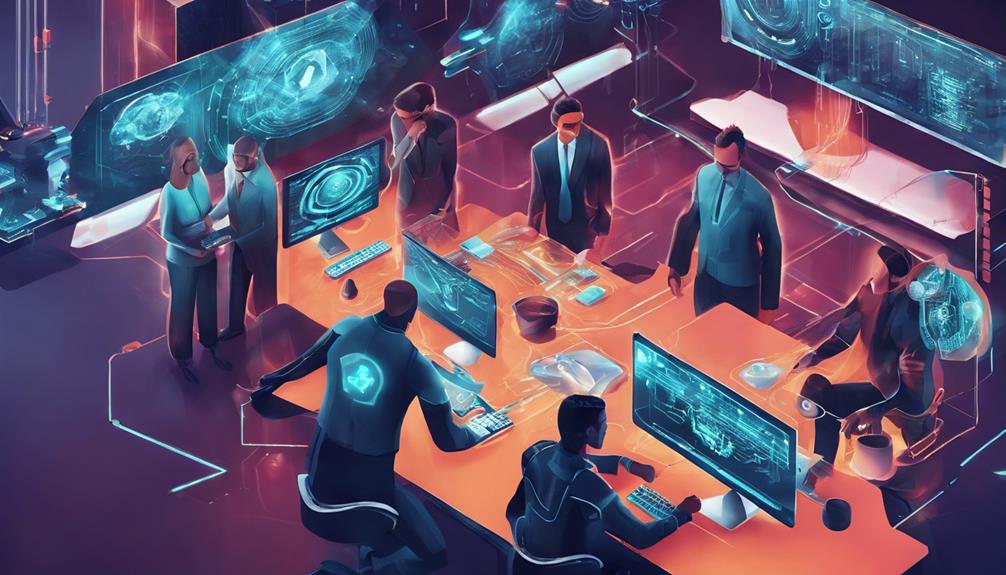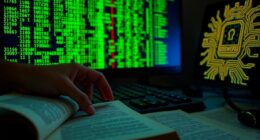Cybersecurity jobs are adapting to AI, enhancing threat detection and streamlining processes. The future promises growth in specialized roles, emphasizing the importance of new skills. Human expertise combined with AI capabilities strengthens defense strategies. Professionals must hone AI and machine learning proficiency, acquire cross-disciplinary skills, and stay updated on AI trends. The evolving landscape demands a fusion of AI technologies and cybersecurity roles. Job security lies in mastering AI integration, understanding algorithms, and embracing cross-disciplinary knowledge for competitiveness. Stay ahead by embracing AI in cybersecurity for future employment stability and advancement opportunities.
Key Takeaways
- AI enhances cybersecurity, but human expertise remains crucial.
- Automation complements tasks, increasing efficiency in cybersecurity operations.
- Future cybersecurity roles will require AI integration and specialized skills.
- AI will create new job opportunities, emphasizing the need for AI proficiency.
- Cybersecurity professionals must adapt by acquiring AI skills for job security.
AI Impact on Cybersecurity Roles
The impact of AI on cybersecurity roles is reshaping the landscape of digital defense strategies and practices. With the integration of AI tools, cybersecurity professionals can now enhance their capabilities in threat detection, data analysis, and prediction.
AI in cybersecurity not only automates routine tasks but also empowers professionals to focus on strategic planning and threat prevention, adapting to evolving challenges in real-time. This shift towards AI-powered systems highlights the need for cybersecurity professionals to embrace new skills and expertise in ethical AI use.
As the job market evolves, the demand for cybersecurity professionals with AI proficiency continues to rise. Organizations are seeking individuals who can effectively leverage AI technology to strengthen their defense mechanisms and safeguard against sophisticated cyber threats.
Automation in Cybersecurity Careers

Automation in cybersecurity careers is revolutionizing the industry by streamlining threat detection and response processes through AI technology. This advancement allows for quicker analysis of extensive data sets, ultimately enhancing cybersecurity measures.
Embracing automation skills alongside traditional cybersecurity expertise equips professionals for the future landscape of cybersecurity roles.
Impact of Automation
The increasing integration of AI tools in cybersecurity careers is revolutionizing operational efficiency. AI and ML are reshaping the landscape of cybersecurity by automating tasks such as threat detection and response. Here are four key impacts of automation in cybersecurity careers:
- Enhanced Data Analysis: AI tools can quickly analyze vast amounts of data, improving security measures and overall performance.
- Global Transformation: Automation through AI is transforming cybersecurity operations worldwide, adapting and learning from new cybersecurity challenges.
- Specialized Roles: The integration of AI in cybersecurity is creating new jobs that require specialized AI expertise within the field.
- Complementary Automation: AI automation complements human skills by handling repetitive tasks, enabling cybersecurity professionals to focus on strategic decision-making.
Embracing AI in cyber security not only streamlines processes but also opens up new opportunities for professionals with the right skill set to thrive in this evolving landscape.
Skills for Future
Developing proficiency in AI and machine learning is essential for cybersecurity professionals aiming to navigate the automated landscape of their careers. As technological advancements continue to shape the cybersecurity industry, having a strong foundation in AI is becoming increasingly vital.
Training programs that focus on AI integration in cybersecurity are imperative for professionals to stay ahead of the curve and adapt to the evolving job market.
Understanding AI algorithms and applications is critical for cybersecurity roles, as AI plays a significant role in automating various aspects of cybersecurity tasks. Cybersecurity professionals must keep themselves updated on the latest AI trends and tools to enhance their skill set and remain competitive in the field.
Cross-disciplinary skills that combine AI and cybersecurity expertise are highly valuable for future job prospects in the automated cybersecurity landscape.
Human Expertise Vs AI in Cybersecurity

Effective cybersecurity defense strategies rely on the synergy between human expertise and AI capabilities to combat evolving threats in the digital landscape.
Human intuition and decision-making skills are paramount in addressing intricate cybersecurity threats, while experienced professionals play a pivotal role in deciphering AI-generated insights for crafting efficient defense strategies.
The collaboration between human expertise and AI tools not only enhances the comprehension of security threats but also bolsters mitigation efforts.
Human professionals are indispensable in overseeing, regulating, and training AI systems within cybersecurity operations. As cybersecurity roles continue to evolve, humans are tasked with supervising critical decisions as AI takes on the automation of routine tasks.
This harmonious blend of human expertise and AI in cybersecurity ensures a robust defense against the ever-changing threat landscape.
Future Job Trends in Cybersecurity

In the field of cybersecurity, the future job landscape is rapidly evolving to accommodate the integration of AI technologies and the demand for skilled professionals in AI security. As AI continues to advance, there are new trends emerging in cybersecurity job roles, creating a need for individuals with specialized skills in AI cybersecurity management and oversight.
The potential for AI to improve cybersecurity practices is evident, leading to a growing demand for cybersecurity professionals who can leverage AI tools effectively.
With an expected 3.5 million unfilled cybersecurity jobs by 2025, the industry is rich with opportunities for those willing to adapt and specialize in AI security. The evolving cybersecurity job market emphasizes the importance of staying updated on AI trends and tools to remain competitive in the field.
As AI integration transforms the industry, cybersecurity professionals with AI expertise will be highly sought after to fill these new specialized roles. It is essential for future professionals to acquire AI and machine learning skills to thrive in the ever-changing cybersecurity landscape.
Adapting Skills for AI Integration

To thrive in the cybersecurity field of the future, professionals must acquire AI and machine learning skills.
Training programs that focus on integrating AI into cybersecurity practices are essential for enhancing job prospects and staying competitive.
Understanding AI algorithms and applications is key to succeeding in cybersecurity roles in the age of AI.
Skill Up for AI
Acquiring proficiency in AI and machine learning has become essential for cybersecurity professionals aiming to stay competitive in the evolving industry landscape.
To skill up for AI integration effectively, consider the following:
- Enroll in Specialized Training Programs: Seek out courses that focus on integrating AI into cybersecurity practices to develop the necessary skills for future job demands.
- Master AI Algorithms: Understanding AI algorithms and their applications in cybersecurity is vital for success in this field. Stay updated on the latest advancements to enhance your capabilities.
- Stay Abreast of AI Trends: Prioritize staying informed about emerging AI trends and tools relevant to cybersecurity to adapt and improve your skill set continuously.
- Develop Cross-Disciplinary Skills: Combining AI and cybersecurity expertise will be highly valuable for future job prospects. Embrace opportunities to bridge these fields and expand your knowledge base for a competitive edge in the industry.
Integration Readiness
Professionals in the cybersecurity industry must enhance their skill sets to guarantee readiness for integrating AI technologies effectively.
As AI continues to reshape the cybersecurity landscape, cyber professionals need to embrace training programs that focus on AI integration.
Understanding AI algorithms and their implications in cybersecurity is paramount for preparing for upcoming job roles that require a blend of AI and cybersecurity expertise.
Cross-disciplinary skills that merge AI knowledge with cybersecurity know-how are increasingly in demand, highlighting the necessity for continuous learning in this evolving field.
Balancing AI and Human Interaction

With the rapid advancements in AI technology, cybersecurity professionals are increasingly focusing on integrating human expertise with AI capabilities to enhance overall security measures. This collaboration between AI tools and human expertise is essential for effectively addressing cybersecurity challenges.
Here are key points to contemplate in balancing AI and human interaction in the cybersecurity field:
- Leverage AI tools: Cybersecurity professionals can harness AI tools to improve efficiency and enhance threat detection capabilities.
- Embrace human expertise: Human skills remain critical for strategic decision-making and adapting to evolving cybersecurity landscapes.
- Ensure job stability: Continuous learning and adaptation to AI technologies are crucial for maintaining job stability in the cybersecurity sector.
- Enhance collaboration: Working together with AI systems allows professionals to focus on complex challenges while AI handles routine tasks, ultimately maximizing the effectiveness of security measures.
Job Security in AI Era

In the field of cybersecurity, ensuring job security in the era of AI involves a delicate balance between utilizing artificial intelligence tools and upholding the irreplaceable value of human expertise. AI is not set to entirely replace cybersecurity professionals; instead, it presents an opportunity for professionals to leverage the power of AI in enhancing their capabilities. Human intuition and strategic decision-making remain critical in facing the challenges AI brings.
AI can be used as a tool to automate routine tasks, allowing professionals to focus on more complex problem-solving, particularly in detection and response scenarios. Continuous learning and adaptation to AI technologies are key to securing job stability in the evolving AI era.
The integration of AI in cybersecurity not only complements human skills but also creates new opportunities for professionals, even in entry-level positions, to develop specialized skills and roles within the industry.
Evolving Employment Landscape

The evolving landscape of cybersecurity employment highlights the increasing integration of AI technologies and the emergence of new roles within the industry.
- The demand for cybersecurity professionals remains vital, indicating job stability despite AI advancements.
- Professionals with cross-disciplinary skills in both cybersecurity and AI are highly sought after in the current job market.
- Continuous learning is essential for cybersecurity experts to adapt to AI trends, ensuring their relevance and employability.
- The integration of AI in cybersecurity is leading to the creation of specialized roles, necessitating professionals to stay updated on the latest AI tools and technologies.
Frequently Asked Questions
Will AI Affect Cyber Security Jobs?
AI will impact cybersecurity jobs by automating tasks, allowing professionals to focus on strategic aspects. Continuous learning and adaptation to AI technologies are essential for job stability. Skilled professionals with expertise in cybersecurity and AI are in high demand.
Is AI a Risk for Cyber Security?
AI presents a significant risk in cybersecurity, as it empowers threat actors to conduct more sophisticated and evasive attacks. The use of AI tools in cyber threats, such as phishing and deep fakes, heightens the complexity of security challenges.
Is AI the Future of Cybersecurity?
AI is unquestionably the future of cybersecurity, revolutionizing threat detection, response, and resilience. Its ability to analyze vast data quickly, predict threats, and adapt to new challenges makes it a critical asset in defending against cyber threats.
What Jobs Are Most at Risk of Being Replaced by AI in the Future?
In the evolving landscape of employment, jobs that involve repetitive tasks or rule-based decision-making processes are most susceptible to replacement by AI technology. Roles like data entry, basic network security monitoring, and routine threat detection are at high risk.
Conclusion
In summary, cybersecurity jobs are evolving with the integration of AI technology. While automation may change certain aspects of the industry, human expertise remains essential in addressing complex cybersecurity threats.
By adapting skills for AI integration and balancing human-machine interaction, cybersecurity professionals can stay ahead in the evolving job market. Job security in the AI era requires continuous learning and upskilling to meet the demands of the changing employment landscape.









